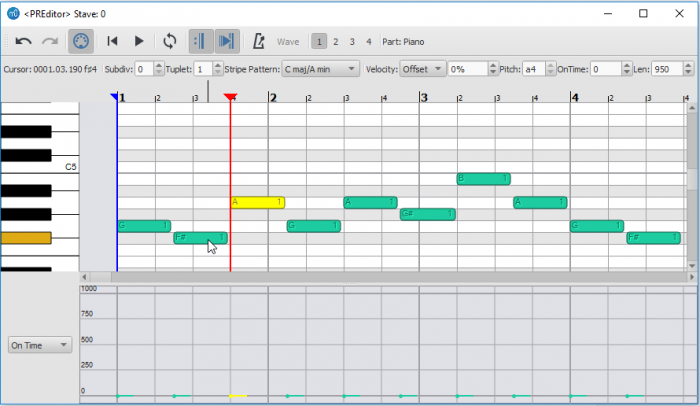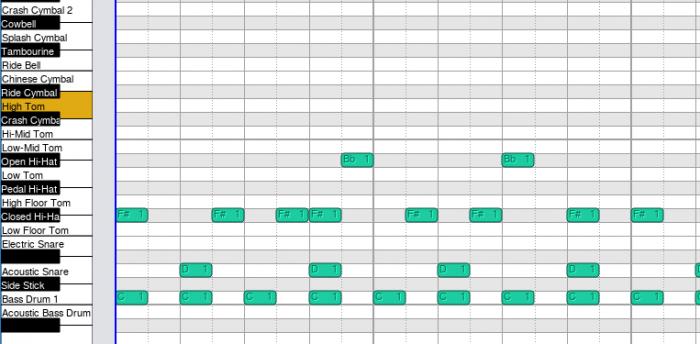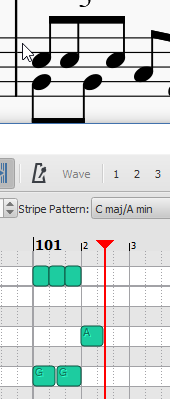钢琴卷帘编辑器
钢琴卷帘编辑器使您可以编辑单独的音符并微调播放效果。
打开钢琴卷帘编辑器
要打开钢琴卷帘编辑器,请在乐谱的小节上右击,然后在菜单中点选点击钢琴卷帘编辑器。钢琴卷帘编辑器将会打开并显示您单击位置的谱表与小节。若钢琴卷帘编辑器已打开,it will be updated to show the new staff and measure you clicked on.

概述

钢琴卷帘编辑器分为以下几个部分:At the very top is a row of buttons and controls that affect playback and can modify notes. The name of the 声部 being edited is at the top right.
The central portion contains the Note Display Area which allows you to view and edit notes. Each note is displayed as a block, with yellow blocks representing selected notes, and darker green blocks representing unselected notes (these colors can be changes in the Preferences). Given sufficient space, each block will display its pitch on the left and the voice it is assigned to on the right. Changing the size of the note blocks is covered in the navigation section.
To the left of the Note Display Area is the Keyboard. By clicking on a key in the Keyboard, you can hear a sample of that note playing. As you move the mouse in either the Node Display Area or the Keyboard, a key on the keyboard will light to corresponding to they pitch your are over. You can also hover your mouse over a particular key to get more information about that pitch. If you are using a Drumkit, the keys of the keyboard will show the name of the drum assigned to that particular pitch. For instruments that are not concert C, the keyboard will be adjusted so that the C of the keyboard matches the C of the instrument.

Along the top of the Note Display Area is the Measure Ruler which displays the current position of the playback head, as well as the current looping range if it set.
The bottom of the editor contains the Levels Display Area. It is a bar graph showing extra data values assigned to each note, such as its velocity or cutoff time. To the left of the Levels Display Area is a dropdown menu allowing you to select the type of data you wish to see displayed or edited.
导航
There are several ways to move about in the Piano Roll Editor. First of all, you can click and drag on the scroll bars on the edges of the Note Display Area.
The mouse wheel can also be used to pan and zoom as follows:
- 垂直滚动:滚动鼠标滚轮。
- 水平滚动:Shift + 鼠标滚轮。
- 垂直缩放:Ctrl + 鼠标滚轮。
- 水平缩放:Ctrl+Shift + 鼠标滚轮。
To jump to a particular measure, switch back to score view and find the measure you wish to see. Then right click on the measure and select Piano Roll Editor. The Piano Roll Editor will scroll to center on the measure you clicked.
选中音符
在音符显示区域中,you can click on single notes or click and drag to select a group of notes. Holding down the modifier keys will affect how your selection changes:
- Shift: 反转选区,例:notes that were previously selected are deselected, and notes which were not selected are selected. Useful for toggling a note between selected and not selected.
- Ctrl: 把音符加入选区。
- Ctrl+Shift: 从选区减去音符。
编辑音符
To change the pitch of a selection of notes: Drag a selected note up or down to a new pitch; or press the ↑ or ↓ arrows. Note: Dragging the note horizontally to change the start time is not supported at the moment.
要删除一个区域的音符:按下Del键。
要把一个区域的音符移到另一个声部:Click the desired voice number button at the top of the editor.
要添加音符:
Notes can be inserted by clicking in the Piano Note Area with the modifier keys held. These edit operations will use the beat or subbeat line to the left of the spot where you click as the point where a note is altered:
-
Ctrl: A note of the current insert note duration will be added at the subbeat and pitch where you clicked. The note insert length is the same as the one you use to add notes in note entry mode in the score. If you wish to change the duration, you will need to select this in the Score View as the Piano Roll Editor does not currently have these buttons. If notes already exist in this location, a chunk will be cut out of them to make room for the note you are inserting, unless they happen to have the same start time and duration of the note you're adding, in which case the new note will simply be appended to the existing chord. Tuplets are currently not supported, and so will be ignored.

-
Shift:Looks for a chord that already spans this subbeat line. If it finds one, appends a new pitch to the existing chord. Otherwise, this is a rest and the rest will be replaced with a note of equal start time and duration to the existing rest.
-
Ctrl+Shift:Looks for a chord or rest that spans this subbeat. This chord will be cut in two at this subbeat line. Tuplets are currently not supported, and so will be ignored.
要编辑音符事件数据:
Note event data can be changed in the Levels Display Area. To edit event data such as velocity or cutoff time, first select the notes you wish to edit in the note area. Then click in the Levels Display Area on the corresponding bar; the value of the level will changed to correspond to the point where you clicked. You can also click and drag in this area to change the levels of several notes with a single gesture. If you want the levels to all be set to the same value, hold Shift while dragging. Only selected notes will have their value changed - this is to prevent you from accidentally changing the values of other notes.
The Levels area can display the same data in multiple ways. For example, velocity data can be displayed both as absolute (ie, relative to the output midi volume) and relative (ie, as an offset to the dynamics value). You can switch between these display modes as you see fit.

控制
From left to right the controls have these functions;
首行
- 撤销
- 撤销前一步操作
- 恢复
- 恢复前一步操作
- MIDI Toggle
- Toggles MIDI input
- Rewind
- Rewind to start of score.
- 播放
- Starts/stops playback.
- 循环播放
- Sets the range of and toggles looping playback.
- 重复记号切换开关
- Toggles whether repeats are played.
- 播放时跟随光标
- If set, the window will automatically scroll to center on the playback head during playback.
- 节拍器
- Toggle metronome.
- 波形
- 目前无用。
- 声部号
- Moves selected notes to chosen voice.
- 分谱
- Name of part currently being viewed/edited.
次行
- 光标位置
- Provides feedback on the current measure and pitch of the position of the mouse within the Note Display Area.
- Subdiv
-
Subdivides the beat by adding extra divisions to the Note Display Area. The value indicated the number of time the beat will be subdivided. So for 4/4 time, a division of 2 will draw grid lines at every eighth note; a division of 3 at every sixteenth note, and so on. Setting the subdivision is necessary for some editing operations if you wish to place notes off the beat.
For larger numbers of subdivisions, you may need to be zoomed in to see the extra grid lines since grid lines are not drawn below a certain density. Combines with the tuplet control which also affects grid line placement.
- Tuplet
-
Adds additional grid lines, subdividing the beat to show the rhythmic placement of tuplets. For example, setting tuplets to 3 will show the beat subdivided into tree parts. Combines with the subdiv control to show subdivisions of the tuplet. For example, setting tuplets to 3 and subdiv to 2 will draw grid lines showing the tuplet beats subdivided into two parts - i.e., the beat will be subdivided into 6.
Selecting a tuplet mode other than 1 will disable some of the note insertion tools for the Piano Roll Editor. For larger numbers of subdivisions, you may need to be zoomed in to see the extra grid lines since grid lines are not drawn below a certain density.

- Stripe pattern
- Changes the pattern of stripes shown behind the notes in the Note Display Area. By default the pitches of C major are highlighted, but you can change this to highlight the pitches of a different key, or even scales such as the diminished or whole tone.
- 力度
-
Shows the velocity of the currently selected note (only one note may be selected). Indicates the loudness of the note. This can be expressed as 'Offset' or 'User':
- Offset: Value is treated as a multiplier for the velocity already set by the dynamics.
- User: This is the raw value being sent to MIDI and overrides the dynamics value. Values are between 0 and 127, where 64 is "middle, neither loud nor soft".
When you switch from User to Offset or visa versa, the value will be recalculated to best match the value in the other system. This way you could, for example, switch to User mode to set the value as you would like it to sound in MIDI output and then switch to Offset so that this value respects the dynamic marking instead of overriding it. At the moment you switch back, the offset value will be recalculated to match the User value in loudness but will no longer act as an override so you may later change the dynamic.
- 音高
- Shows the pitch and octave of the selected note in text format (i.e. f#4).
The pitch will chance if the note is dragged Up or down to a new pitch. Currently cannot be edited. - 起始时间
- Shifts the start of the note in time, which can be used to modify the playing style. Negative values will make the note sound earlier, positive will make it sound later. The duration of the note corresponds to a value of 1000 (e.g. setting the value to 250 will make the note sound 1/4 of its duration later).
- 长度
- Set the time that the note is sounding, which may be used to modify the degree of "legato". Lower values will make the note sound more staccato, higher values will make it sound more legato. The duration of the note corresponds to a length of 1000, but the value can be set higher. 950 is usually considered "non-legato".
键盘
Some keys are hooked up to perform special actions:
- ↑: Move selected notes up one semitone
- ↓: Move selected notes down one semitone
- Del: Delete selected notes
- Space: Start/stop playback
定制
The Piano Roll Editor will display in both normal mode and dark mode. If you wish to change the colors the Piano Roll Editor uses to display in these modes, they can be adjusted in the Preferences under the Advanced tab. All the Piano Roll Editor related properties begin with ui/pianoroll/light for light mode and ui/pianoroll/dark for dark mode.